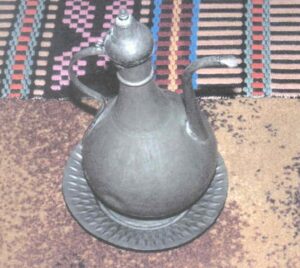Lesvos
The father of the child has the first word about the name. But if they were asking someone to baptize the baby, then he/she could ask to choose the name. Usually first, the names of the husband’s parents are given, and then the wife’s parents. The godmother/godfather of the baby could order assets to the baby.
The invitations for the baptism were made with almonds, which were put in a box and distributed by the mother or a relative. Usually, apart from the close relatives, they also invited those who had taken a gift to the baby at birth.
The Legenomiriko
In the old days the baptism was made at home in font that were brought from the church. Later, when the baptism began to take place in the church, the mother took the water of the baptism. In a Legenomiriko (Lagini) He put the hot water and the cold in a pitcher. When he poured the water into the Legenomiriko, he should not have interrupted the flow, because if there was a break, the child would become stutter.
The Holy Zone
The christening oil was taken by the godmother along with the baby’s clothes, which she made herself. With the baby’s clothes, the godmother also made the amulet, the “Holy Zone“. This amulet, red and white thread braided together, was worn by the priest around the baby’s neck after the baptism. It was necessary for this amulet to stay on the baby for forty days, a custom that is preserved until today.
Anevoli
The godmother’s obligation was to make or buy a cloth, the so-called Anevoli, which during the baptism was thrown on her shoulders. This fabric symbolized the easy and smooth passage of the godmother to the other world or the common course of the godmother and the baby, since it becomes his spiritual mother, or even the smooth course of the child in life. This fabric after the baptism was given to mother to make a dress.
After the sacrament and before the godmother delivered the baby to the mother, the mother made regrets to the godmother and then took the baby. In the church and after the sacrament of Baptism, the godmother was flying behind her coins, which the children were collecting.
It should be noted that he did not make haircut to the child from birth to baptism or cut off his fingernails. It was the priest who would cut the first Tsilitikas (of the abdomen) hair and nails after the baptism.
Upon completion of the mystery, the close relatives went to the house for a treat. If the baby’s parents were in good financial condition, he was following a music feast.
The baby’s first bath after baptism was held in 3 days. The godmother washinged the baby’s clothes and the water had to throw it somewhere where there was no chance of it being pressed. The very old years took it and threw it in the precincts of the church, usually in the roses or behind the holy step.
A few days after the christening, mother was making a sweet, buying a shirt and with the baby she was visiting the godmother.
